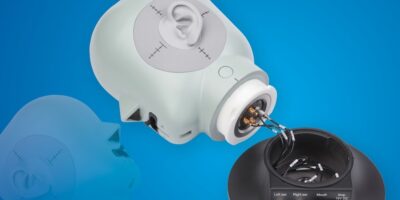HATS help test smartphone audio
Designed for realistic, in-situ electroacoustics tests on, for example, smartphones, headsets, audio conference devices, microphones, headphones, hearing aids, hearing protectors and smart speakers, the Type 5128 high-frequency Head and Torso Simulator (HATS) have been developed by Brüel & Kjær. They have built-in realistic ear and mouth simulators and are claimed to provide a realistic reproduction of the acoustic properties of an average adult human head and torso. High-frequency HATS can cover the full audible frequency range (up to 20kHz).
They can be used to test smartphone audio performance in relation to national and international standards for communication quality. This includes testing of mobile and wireless handsets. They can also be used to evaluate the intelligibility of headset two-way communication in the presence of background noise and conditions that may produce feedback into the system. They can also evaluate speech intelligibility in two-way communication using hands-free devices such as conference phones and smart speakers. This evaluation is based on the accurate production of human speech directivity, intelligibility, feedback and background noise suppression.
They can also facilitate the evaluation of microphone recording accuracy for human speech with variations in level, directivity and sibilance. They measure the audio response of headphones in the same way a human would perceive the quality. This allows designers to identify and correct anomalies in headphone design that lead to artefacts in the frequency response. The new ear canal design provides the most benefits to designers of in-ear headphones, says Brüel & Kjær, where the geometric fit is crucial to the evaluation.
They HATS can also be used for sound quality evaluation of hearing aids with correct anatomical positioning and to measure the attenuation and effective sealing of hearing protectors with the correct ear canal geometry and head anatomy.
Core HF HATS Type 5128-C is available without ears or mouth for simpler applications. The head and torso geometry of Type 5128-C complies with ITU-T Rec. P.58, IEC 60318-7 and ANSI S3.36-1985.
Another model is the Type 5128-D, which includes handset positioner Type 4606. The handset positioner enables a smartphone to be precisely positioned on the HATS for easier test set-ups and better data quality from electroacoustic tests.
The head and torso geometry of Type 5128-D complies with ITU-T Rec. P.58, IEC 60318-7 and ANSI S3.36-1985.
Type 5128-B is a tabletop HATS that is a torso-less head supported on a foot. It is suitable for testing all types of headphones, and can be used free standing on a desk, fitted on a tripod or on a turntable using a tripod mounting adapter. It is configurable and includes two ear simulators. The support foot UA-2180 is available as an optional accessory for HF HATS Types 5128-C and -D.
The head geometry of Type 5128-B complies with ITU-T Rec. P.58, IEC 60318-7 and ANSI S3.36-1985.




